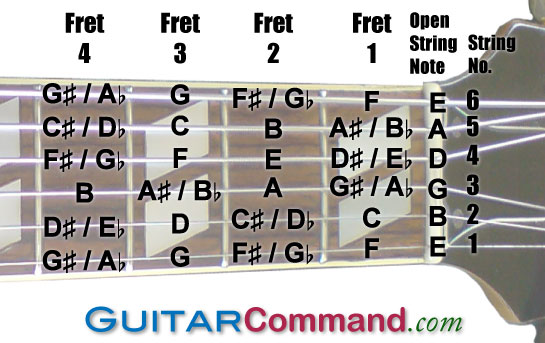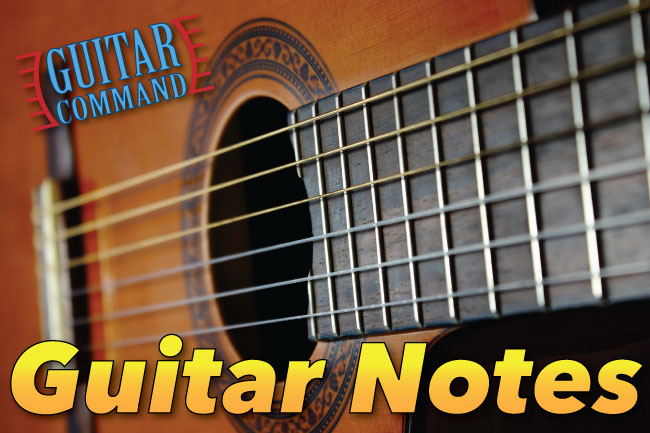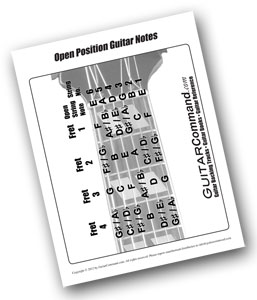

Guitar notes should be learned early on in your playing career. This page will help you to learn the notes on a guitar fretboard, with diagrams and charts.
First we'll look at notes in open position, then we'll look at the whole of the guitar neck.
You can also download a free printable PDF of the guitar neck, showing all the note names in open position.
Although at first you can get by with just learning the shapes of chords and scales, you'll eventually need to learn the names of the notes you are playing.
This will help you to communicate with other musicians, and will also improve your knowledge and enjoyment of music.
Knowing how notes relate to each other in scales and chords will benefit your songwriting, lead guitar improvisation and general musicianship. So let's get started .
First we'll learn notes in 'open position'.
Guitar notes on the fretboard in open position are shown on the diagram below:

The diagram above shows guitar notes in open or first position. This is the position of your fretting hand when playing open strings and notes in the first four frets.
In guitar music, the fretboard 'position' means the fret at which the index finger of the left hand is positioned over.
You can download a free PDF chart of the guitar notes in open position by clicking on the image below.

Once you've learned the notes in open position, start working your way up the fretboard. The chart below shows the notes up to the twelfth fret. After this the notes repeat an octave higher (i.e. the 13th fret of the 6th string is an F; the same as the 1st fret of the same string).
Notice that many notes on the guitar fretboard have more than one name – for example, an F sharp (F#) can also be called a G flat (Gb).
As you progress, you'll learn that notes can also have 'double sharps' and 'double flats', giving each note even more potential names.
The name you use to refer to a particular note depends on what key you're currently playing in. It's quite a tricky area, but usually you'll be understood whichever name you call the note.
You'll also notice that the same note can often be played at several different places on the fretboard. Although confusing at first, this feature of the guitar can be used to make certain music easier to play. With a choice of frets to play the same note, you can pick the fret that's easiest to reach!
Compare this feature of the guitar fretboard to a piano keyboard, in which there is only ever one way of playing each note.

Eventually, you'll come to learn the note names naturally as you play the guitar. However, it will greatly aid your understanding not just of the instrument but also of music in general if you make an effort to learn the notes of the guitar at an early stage.
You can of course learn the Guitar Notes Diagram above off by heart, but a better way is by playing chords and scales that you already know, and working out which notes they contain as you play them.
This way you will learn not just the note names, but also where they occur and how chords and scales are built.
This will put you ahead of the game. You'd be surprised how many experienced guitarists have to think about which notes they are playing if put on the spot!
The best way of all to learn guitar notes – and this is for guitarists of all levels – is to say the notes aloud as you play them. You can do this with scales or chords.
Try this now by playing a scale that you know – for example a major scale – and saying the note names either aloud or mentally.
You may be surprised how hard this is! You'll also find how quickly you start to learn your guitar notes if you practise this regularly!
We hope that the charts and diagrams on this page have helped you to get better acquainted with your fretboard!
Take a look at some other articles here on Guitar Command and improve your playing!